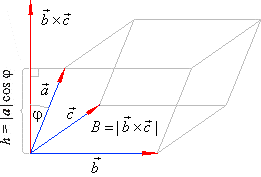|
|
Vectors in a Plane and Space |
|
 The mixed product
or the scalar triple product
The mixed product
or the scalar triple product |
|
The mixed product
or scalar triple product definition |
|
The
mixed product properties |
|
The condition for
three vectors to be coplanar |
|
The mixed product
or scalar triple product expressed in terms of components |
 The vector product
and the mixed product use, examples
The vector product
and the mixed product use, examples |
|
|
|
|
|
|
|
| The mixed product |
| The
mixed product or scalar triple product definition
|
| The
mixed product (or the scalar triple product) is the scalar product of the first vector with the vector product of the other two
vectors denoted as a
· ( b ´
c ).
|
|
Geometrically, the
mixed product is the volume of a parallelepiped defined by vectors,
a ,
b
and c
as shows the right figure.
|
The vector b
´
c is perpendicular to the base of the
parallelepiped and its magnitude equals the area of
the
|
|
base, B =
| b ´
c
|.
|
The altitude of the parallelepiped is projection of the
vector a in the direction of
the vector
b ´
c,
so
|
|
h =
| a | · cos j.
|
|
 |
|
| Therefore, the scalar product of the vector
a
and vector
b ´
c
is equal to the volume of the parallelepiped.
|
|
|
| The sign of the scalar triple product can be either positive or negative, as
a
· ( b ´
c ) =
-
a
· ( c ´
b ).
|
|
| The
mixed product properties |
 |
|
| The condition for
three vectors to be coplanar |
The
mixed product is zero if any two of vectors, a ,
b
and c
are parallel, or if a ,
b
and c
are coplanar. That is,
when the given three vectors are coplanar the altitude of the parallelepiped is zero and thus the scalar triple
product is zero, |
|
|
|
| The
mixed product or scalar triple product expressed in terms of components |
| The scalar triple product expressed in terms of the components of vectors,
a =
axi + ay j + azk, |
| b
= bxi + by j +
bzk
and c
= cxi + cy j +
czk, |
|
|
| The above formula can be derived from the determinant expanded by minors through the elements of the
first row, |
 |
| Therefore, vectors,
a,
b
and c
will be coplanar if the determinant is zero. |
|
| The vector product
and the mixed product use examples |
| Example: Given are vectors,
a
= -2i -
3 j,
b
= -i -
2
j + 3k
and c
= -i +
2
j + k,
find the projection
(the scalar component) of the vector a
onto vector d
= b ´
c.
|
| Solution:
Let first find
the vector d, |
 |
 |
|
Example: Given are vectors,
a
= -3i +
4 j -
l
k,
b
=
2i -
j + k
and c
= i
-
4 j -3l
k,
determine the
parameter l
such that vectors to be coplanar. |
Solution:
Vectors lie on the same plane if their scalar triple product is zero, i.e.,
V =
0, therefore vectors’
coordinates must satisfy the condition, |
 |
|
| Example: Examine if vectors,
a
= 4i + 2 j +
k,
b
= 3i + 3 j -
2k
and c
= -
5i
-
j -
4k,
are coplanar and if so,
prove their linear dependence. |
| Solution:
Check for coplanarity, |
 |
| Since vectors are coplanar each of them can be represented as linear combination of other two. |
 |
|
| Example: Prove that points,
A(-2,
1, 0), B(3,
-2,
-1), C(1,
-1,
2) and D(-3,
2, -5),
all lie on the same plane. |
| Solution:
If all given points belong to the same plane then vectors,
AB,
AC
and AD
are coplanar, therefore the scalar triple product (AB
´
AC)
· AD
= 0. |
 |
 |
| thus, all
given points lie on the same plane. |
|